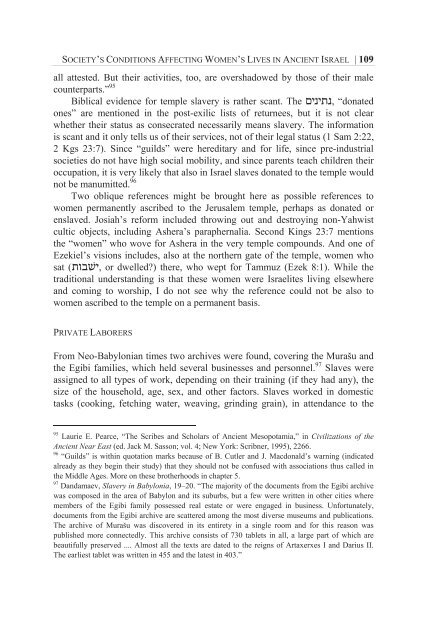Women at Work in the Deuteronomistic History - International Voices ...
Women at Work in the Deuteronomistic History - International Voices ...
Women at Work in the Deuteronomistic History - International Voices ...
You also want an ePaper? Increase the reach of your titles
YUMPU automatically turns print PDFs into web optimized ePapers that Google loves.
SOCIETY’S CONDITIONS AFFECTING WOMEN’S LIVES IN ANCIENT ISRAEL | 109<br />
all <strong>at</strong>tested. But <strong>the</strong>ir activities, too, are overshadowed by those of <strong>the</strong>ir male<br />
counterparts.” 95<br />
Biblical evidence for temple slavery is r<strong>at</strong>her scant. The םיניתנ, “don<strong>at</strong>ed<br />
ones” are mentioned <strong>in</strong> <strong>the</strong> post-exilic lists of returnees, but it is not clear<br />
whe<strong>the</strong>r <strong>the</strong>ir st<strong>at</strong>us as consecr<strong>at</strong>ed necessarily means slavery. The <strong>in</strong>form<strong>at</strong>ion<br />
is scant and it only tells us of <strong>the</strong>ir services, not of <strong>the</strong>ir legal st<strong>at</strong>us (1 Sam 2:22,<br />
2 Kgs 23:7). S<strong>in</strong>ce “guilds” were hereditary and for life, s<strong>in</strong>ce pre-<strong>in</strong>dustrial<br />
societies do not have high social mobility, and s<strong>in</strong>ce parents teach children <strong>the</strong>ir<br />
occup<strong>at</strong>ion, it is very likely th<strong>at</strong> also <strong>in</strong> Israel slaves don<strong>at</strong>ed to <strong>the</strong> temple would<br />
not be manumitted. 96<br />
Two oblique references might be brought here as possible references to<br />
women permanently ascribed to <strong>the</strong> Jerusalem temple, perhaps as don<strong>at</strong>ed or<br />
enslaved. Josiah’s reform <strong>in</strong>cluded throw<strong>in</strong>g out and destroy<strong>in</strong>g non-Yahwist<br />
cultic objects, <strong>in</strong>clud<strong>in</strong>g Ashera’s paraphernalia. Second K<strong>in</strong>gs 23:7 mentions<br />
<strong>the</strong> “women” who wove for Ashera <strong>in</strong> <strong>the</strong> very temple compounds. And one of<br />
Ezekiel’s visions <strong>in</strong>cludes, also <strong>at</strong> <strong>the</strong> nor<strong>the</strong>rn g<strong>at</strong>e of <strong>the</strong> temple, women who<br />
s<strong>at</strong> (תובשׁי, or dwelled?) <strong>the</strong>re, who wept for Tammuz (Ezek 8:1). While <strong>the</strong><br />
traditional understand<strong>in</strong>g is th<strong>at</strong> <strong>the</strong>se women were Israelites liv<strong>in</strong>g elsewhere<br />
and com<strong>in</strong>g to worship, I do not see why <strong>the</strong> reference could not be also to<br />
women ascribed to <strong>the</strong> temple on a permanent basis.<br />
PRIVATE LABORERS<br />
From Neo-Babylonian times two archives were found, cover<strong>in</strong>g <strong>the</strong> Murašu and<br />
<strong>the</strong> Egibi families, which held several bus<strong>in</strong>esses and personnel. 97 Slaves were<br />
assigned to all types of work, depend<strong>in</strong>g on <strong>the</strong>ir tra<strong>in</strong><strong>in</strong>g (if <strong>the</strong>y had any), <strong>the</strong><br />
size of <strong>the</strong> household, age, sex, and o<strong>the</strong>r factors. Slaves worked <strong>in</strong> domestic<br />
tasks (cook<strong>in</strong>g, fetch<strong>in</strong>g w<strong>at</strong>er, weav<strong>in</strong>g, gr<strong>in</strong>d<strong>in</strong>g gra<strong>in</strong>), <strong>in</strong> <strong>at</strong>tendance to <strong>the</strong><br />
95 Laurie E. Pearce, “The Scribes and Scholars of Ancient Mesopotamia,” <strong>in</strong> Civiliz<strong>at</strong>ions of <strong>the</strong><br />
Ancient Near East (ed. Jack M. Sasson; vol. 4; New York: Scribner, 1995), 2266.<br />
96 “Guilds” is with<strong>in</strong> quot<strong>at</strong>ion marks because of B. Cutler and J. Macdonald’s warn<strong>in</strong>g (<strong>in</strong>dic<strong>at</strong>ed<br />
already as <strong>the</strong>y beg<strong>in</strong> <strong>the</strong>ir study) th<strong>at</strong> <strong>the</strong>y should not be confused with associ<strong>at</strong>ions thus called <strong>in</strong><br />
<strong>the</strong> Middle Ages. More on <strong>the</strong>se bro<strong>the</strong>rhoods <strong>in</strong> chapter 5.<br />
97 Dandamaev, Slavery <strong>in</strong> Babylonia, 19–20. “The majority of <strong>the</strong> documents from <strong>the</strong> Egibi archive<br />
was composed <strong>in</strong> <strong>the</strong> area of Babylon and its suburbs, but a few were written <strong>in</strong> o<strong>the</strong>r cities where<br />
members of <strong>the</strong> Egibi family possessed real est<strong>at</strong>e or were engaged <strong>in</strong> bus<strong>in</strong>ess. Unfortun<strong>at</strong>ely,<br />
documents from <strong>the</strong> Egibi archive are sc<strong>at</strong>tered among <strong>the</strong> most diverse museums and public<strong>at</strong>ions.<br />
The archive of Murašu was discovered <strong>in</strong> its entirety <strong>in</strong> a s<strong>in</strong>gle room and for this reason was<br />
published more connectedly. This archive consists of 730 tablets <strong>in</strong> all, a large part of which are<br />
beautifully preserved .... Almost all <strong>the</strong> texts are d<strong>at</strong>ed to <strong>the</strong> reigns of Artaxerxes I and Darius II.<br />
The earliest tablet was written <strong>in</strong> 455 and <strong>the</strong> l<strong>at</strong>est <strong>in</strong> 403.”




